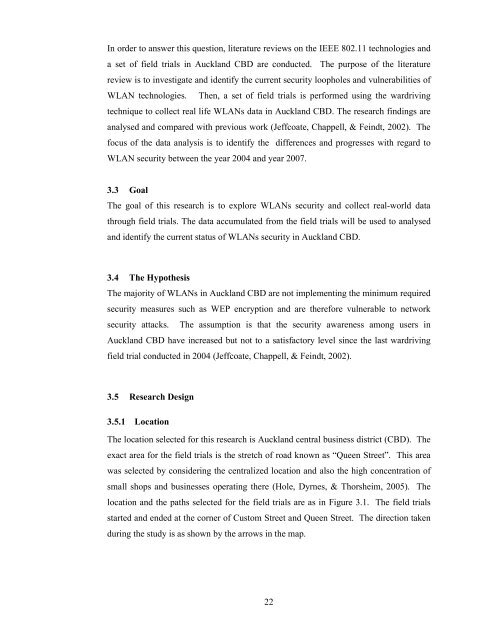AIS300 - Scheme of Work - Scholarly Commons Home
AIS300 - Scheme of Work - Scholarly Commons Home
AIS300 - Scheme of Work - Scholarly Commons Home
You also want an ePaper? Increase the reach of your titles
YUMPU automatically turns print PDFs into web optimized ePapers that Google loves.
In order to answer this question, literature reviews on the IEEE 802.11 technologies and<br />
a set <strong>of</strong> field trials in Auckland CBD are conducted. The purpose <strong>of</strong> the literature<br />
review is to investigate and identify the current security loopholes and vulnerabilities <strong>of</strong><br />
WLAN technologies. Then, a set <strong>of</strong> field trials is performed using the wardriving<br />
technique to collect real life WLANs data in Auckland CBD. The research findings are<br />
analysed and compared with previous work (Jeffcoate, Chappell, & Feindt, 2002). The<br />
focus <strong>of</strong> the data analysis is to identify the differences and progresses with regard to<br />
WLAN security between the year 2004 and year 2007.<br />
3.3 Goal<br />
The goal <strong>of</strong> this research is to explore WLANs security and collect real-world data<br />
through field trials. The data accumulated from the field trials will be used to analysed<br />
and identify the current status <strong>of</strong> WLANs security in Auckland CBD.<br />
3.4 The Hypothesis<br />
The majority <strong>of</strong> WLANs in Auckland CBD are not implementing the minimum required<br />
security measures such as WEP encryption and are therefore vulnerable to network<br />
security attacks. The assumption is that the security awareness among users in<br />
Auckland CBD have increased but not to a satisfactory level since the last wardriving<br />
field trial conducted in 2004 (Jeffcoate, Chappell, & Feindt, 2002).<br />
3.5 Research Design<br />
3.5.1 Location<br />
The location selected for this research is Auckland central business district (CBD). The<br />
exact area for the field trials is the stretch <strong>of</strong> road known as “Queen Street”. This area<br />
was selected by considering the centralized location and also the high concentration <strong>of</strong><br />
small shops and businesses operating there (Hole, Dyrnes, & Thorsheim, 2005). The<br />
location and the paths selected for the field trials are as in Figure 3.1. The field trials<br />
started and ended at the corner <strong>of</strong> Custom Street and Queen Street. The direction taken<br />
during the study is as shown by the arrows in the map.<br />
22

















